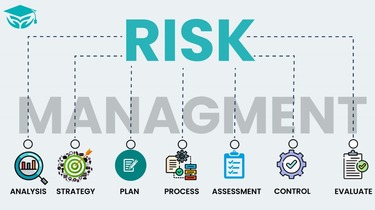
Introduction
An organization is where multiple administering bodies coordinate to generate a principal amount of capital and profit. Employees are the main essence of an organization; they are the key who efficiently work on a targeted theme of any particular organization and bring in expected profits.
While running an organization, damage control measures are taken beforehand or kept as a first recommendable resort. Risk management is one of the damage control tactics for which every actively and ethically working organization should opt. It identifies and assesses risk factors affecting the employee workflow, financial spectrum, or other safety and miscellaneous issues like organizational or workplace ethics.
The role of administrative or managerial parties in risk management is to look after the situation, step in as coordinators for the situation, and look into factors leading to any risk.
Areas of Risk Management
Talking about the themes and dimensions risk management covers are quite vast. Firstly, compensation and benefits are the first areas of concern in risk management, and it covers the chances of discrepancies that could occur in the process of benefits submission. Certain situations can arise when employees could feel discriminated against based on benefit distribution or the organization withholds their benefits and compensations.
Secondly, the hiring process is the area which covers the chances of discrepancies which could occur during the hiring process. Conducting the hiring process unethical or accepting bribe-based offers could be the situation of concern.
Thirdly, occupational health and safety is an area that includes basic environment-related safety and sanitation issues like tardiness and contamination at the workplace. Even inconsiderate corners could be hazardous for the prevailing employees in the firm.
Fourth, employee suspension and conduct is an area which highlights the scenario when an employee is suspended or held for conduct after releasing confidential information about the organization.
Lastly, employees exit the organization after being discontent with the management or authority of the organization due to anonymous issues.
Risk Management Analysis
As mentioned above, parties responsible for intervening in risk management are the organization’s human resources department and the management cum administrative authorities of that particular organization. Two factors which are the basis of the risk management spectrum are risk analysis and risk prioritization.
Risk analysis highlights the assessment of risk and its severity and what parameters can affect the formulation of an organization. Under risk analysis comes cost risk analysis, which focuses on the different financial links associated with the organization and holds the potential to affect other factors. Schedule analysis is a planned procedure targeted toward improving the predictability and performance of the project. Reliability and decision analysis look into whether authorities should intervene in risk management or not.
Risk prioritization emphasizes measuring the severity of the overall risk and applying which protocol tactics could be handled ethically by the concerning parties.
Ways to diminish the chances of any risk occurrence in an organization
Risk management is all about altering the potential chances of any risk that’d affect the working of an organization. Below are the suggestive measures that cut down the probability of risks and discrepancies.
- Establishing an intact recruitment and hiring plan reflects embedding proper norms and systems while hiring. Norms and systems among the targeted audience to avoid the chance of risk occurrence.
- Staying up to date with the trends and developments in the organizational sector, accepting and implementing the rules and regulations officiated by the federal government.
- Creating an inviting culture with a pleasant yet ethical environment in the workplace eliminates employees’ chances of discontent with the organization’s policies and work.
Identifying risks and elements into the consideration
Risk management emphasizes identifying potential opportunities that could be recognized as risk situations. The approach to handling certain risks differs. Certain situations could be left unnoticed, the concerning authorities could look into some, and some had to be ignored. The severity of the situation and the considerate effect on the organization and employees decided the approach of interference of the subject parties.
Risk management begins by establishing the context that determines what terms and parameters of human resources are considered as threat. Identifying the risk and investigating the root causes and consequences of it. Then comes the evaluation phase, in which all the factors are undermined and investigated solely or correlatively. After the conclusive evaluation comes effective intervention in which factors creating the risk are examined, eliminated or treated efficiently. And then addressing the risk, acknowledging the concerned groups and audience, and suggesting considerate measures and tactics to deal with risk.
Human Resource Risk Management
Human resources do play a crucial role in the risk management process. It monitors the situation and suggests or takes action while considering the set of suggestive norms and protocols. Yet the human resource department of any particular organization is in charge of recognizing potential employee-based risks or threats that could affect the employee’s engagement with the firm. Employee-related risks can negatively impact the business’s revenue, reputation, and other aspects.
The human resources department in charge of risk management is responsible for intervening in such situations and is devoid of discrepancies.
Human resources can also educate their employees and staff by enrolling them in risk management training courses.
Risk management courses enable employees and learners to handle risk situations and make them aware of accountable roles and involvement in the risk situation. Risk management education courses are an asset-centric initiative that should be adopted by prevailing organizations to keep their resources intact and updated with the risk-controlling situation. Considering the online accessibility trend, employees working in any organization who are willing to expand their horizon in learning about horizon behavior should opt for a certificate course in risk management or could also enroll in a part-time risk management course online.
Also, human resources should suggest enrolling their employees in regulatory compliance training to keep the employees and staff updated with the recent developments in the code of conduct and rules and regulations in organizational behaviour.
Risk Management Control Tactics
Risk is a potential situation of threat or discrepancies. Large-scale firms do have separate teams to manage the risk management situation in their company. Their teams are human resources associates as a mentoring body and authoritarian parties as key decision-makers. The key to having control over the risk management situation is to keep a time-to-time check on prevailing human resources and the quality of functioning in the organization or whether employees are satisfied with the prevailing code of the system. An open and friendly medium should be present for employees where they can express their concerns and suggestions to the administrative bodies.
Conclusion
Risk management is a system of controlling or intervening in possible discrepancies in situations in an organization. Human resources play a primary and active role in managing the risk situation in an organization. The human resources department of any firm is responsible for looking after whether the employees follow the code of conduct or ethics. Secondly, rigid bodies of the company are involved in the risk management process. Suggestively, the human resources department of every firm should supportively appreciate their employees to opt for risk management courses to enhance their prevailing resources with valid and beneficial management learnings.




